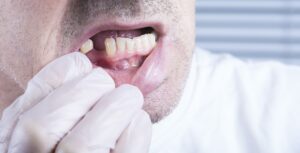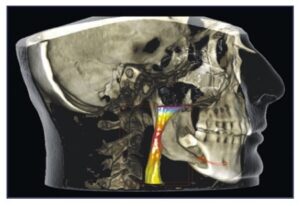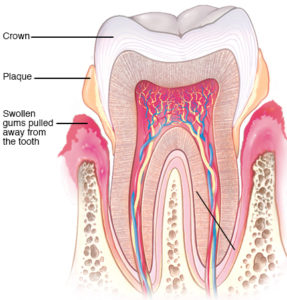Header logo
header top contact widget
Tooth Loss
The “Why” & “How” of Dental Implants
Posted on Nov 09, 2022 by William J. Claiborne, DDS MS
According to the Centers for Disease Control & Prevention (CDC), over one-fourth (26%) of American adults ages 65 and older have 8 or less natural teeth. The CDC equates this number (having 8 or fewer teeth) as “severe tooth loss” since it impacts an individual’s ability to thoroughly eat a healthy diet.
An even worse statistic shared by the CDC is 1 in 6 (17%) adults ages 65 and older have lost all of their teeth.
When it comes to losing natural teeth, they also share that the most vulnerable older adults are those who are poor, have less than a high school education, or are cigarette smokers.
Being totally edentulous (having lost all teeth) amongst the 65 or older age group has fortunately declined over the years. The CDC shared that the figure dropped by more than 30% from 1999–2004 (when it was 27%) to 17% in 2011–2016. At least American adults are moving in the right direction.
https://www.cdc.gov/oralhealth/fast-facts/tooth-loss/index.html
Tooth loss is a bigger deal than is assumed by a large segment of the population. When a natural tooth is removed, its absence causes a reaction that begins below the gum line. What occurs initially is typically not obvious. Yet, the repercussions of “resorption” can become quite the dilemma.
The absence of a tooth root in the upper or lower jaw bone is a loss of stimulation to the bone mass where it was once positioned. These roots provide both stimulation and nourishment that enables the bone to maintain a healthy mass. Without the presence of tooth roots, the bone begins to “melt away.” This process is known as resorption.
Think of the stimulation that tooth roots provide to how you might muscle atrophy. We all know that muscles, not used, will shrink in mass. When the jaw bones are lacking stimulation by the tooth roots they’re designed to hold, bone mass begins to shrink.
Resorption begins shortly after the tooth root is removed. Once it starts, it continues at an ever-increasing pace. For example, the first year after a tooth root is missing, the loss of bone may be minimal. With each passing year, the pace of loss accelerates.
As the bone shrinks in height, the natural tooth roots adjacent to the area of missing teeth are subject to movement and root damage. On average, the next teeth you’re most likely to lose are the ones bordering areas of missing teeth.
Obviously, it is important to replace lost teeth before bone loss begins. For the support of remaining natural teeth, it’s also important to replace missing teeth as soon as possible so adjacent teeth can retain their proper positions. And, it’s HOW you replace them that’s most important.
Because dental implants replace the tooth above the gum line AND the root portion below it, the bone is able to retain its mass. Through the sturdy foundation of the jaw bone, dental implants are able to restore the look, feel and chewing stability like that of natural teeth.
As a periodontist, I specialize in the prevention, diagnosis, and treatment of all stages of periodontal (gum) disease. I also have advanced training and skills in the selection and placement of dental implants. In addition, periodontists are particularly skilled in performing cosmetic periodontal procedures.
Our Western NC periodontal dental office features some of the most advanced technology available. This cutting edge technology is beneficial in a number of ways, with much specifically helpful in optimal dental implant diagnosis and planning. This includes:
LANAP With PerioLase MVP 7 – Laser-Assisted New Attachment Procedure is an advanced protocol that efficiently and effectively treats advanced gum disease with the added advantages of a dental laser. For patients who are preparing for dental implant placement, resolving gum disease prior to treatment is mandatory. LANAP offers a non-surgical alternative for patients with moderate to severe periodontal disease with very little discomfort and a quick recovery time.
Cone Beam Imaging – These amazing 3D “x-rays’ are ideal for diagnosing and treatment planning. The highly-detailed images provide a clear view of the upper and lower jaw. Because cone beam radiographs show sagittal, axial, and coronal planes, locating and tracking nerve canals optimizes implant placement. The images are captured in a quick, painless process and at minimal levels of radiation.
CareStream Cone Beam Computer Tomography Imaging – This enhanced tomography works with 3D imaging for exceptional detail and range.
Computerized Dental Implant Placement – This system provides the futuristic ability to position dental implants before the process actually begins. Through computerized technology, the implants are selected and “ideally positioned” on a 3D model of the patient’s jaw. From this, a template is developed for optimal treatment success, even for complex cases.
CS 3600 Intraoral Scanner – Rather than make impressions with bulky, goopy trays, this scanner quickly and comfortably captures digital impressions accurately and easily. These are used to create precision models or appliances (dental implant crowns, bridges, or full arches). The scanner can also reach hard–to–access areas in the patient’s mouth for superior results with improved patient comfort.
Sedation – Our Asheville periodontal practice is known for its environment of comfort and respectful care. We understand that over 70 percent of the adult population have some level of dental fear or anxiety. For optimal comfort and relaxation, we offer several sedation options, including oral and IV sedation. With both sedation options, patients are closely monitored with advanced safety equipment throughout treatment.
• Oral sedation is a pill that helps patients relax. It also has an amnesiac effect, leaving most with little or no memory of treatment afterward.
• I.V. sedation (also known as ‘twilight sleep‘) places the patient in a deeper sleep state and erases memory of the procedure. It is administered by a Medical Doctor (MD) who is a board certified Anesthesiologist.
Ideal diagnosis is important, and can save the patient much in overall treatment costs. For example, when missing more than one tooth in one area, one implant can often hold two or a bridge of teeth. Several strategically-placed implants may also be used support a full arch of teeth.
Dental implants restore the ability to eat with stability, chew comfortably, laugh and speak with confidence. Dental implants do not decay and will never need root canals. They have an extremely high success rate, higher than any implant-in-bone option. And, Dental Implants are designed to last a lifetime. With proper selection and maintenance, they will never need replacing or repair.
Dental implants come in many sizes and shapes, each system designed to accommodate various needs and preferences. This means your implant can be chosen to suit your long-term goals.
Proper placement and support in caring for implants is an important part of a successful outcome. However, dental implants can fail. This is why a periodontal specialist can be an asset to your investment. When dental implants are chosen and placed by a Periodontist, he or she can select the one that will work best for you now and throughout your lifetime.
In our Asheville periodontal dental office, we combine technology with our advanced skills and compassionate approach to care so you can enjoy a comfortable, efficient experience that allows you to have optimal success.
Call 828-274-9440 to arrange a consultation. During this time, we can discuss treatment that can achieve your needs and goals as well as the process and anticipated costs.
Men Have Unique Challenges When Oral Health Is Poor
Posted on Oct 18, 2022 by William J. Claiborne, DDS MS
In almost any fitness center, you’ll see guys lift weights, sweat buckets on the stair climber, and use the rowing machine like mad. Men can be pretty appearance-conscious when it comes to their physique. Yet, when it comes to their smiles, their track record is not so impressive.
According to the National Institute of Health, a gender-based study of college students concluded that women were far better at brushing than men. Another study’s findings (published in the Journal of Periodontology) showed that men were less likely to brush regularly, schedule regular dental checkups, and follow through with recommended dental treatment.
While women are doing a better job, it is necessary due to their own challenges. A female’s fluctuating hormone levels as they go through different stages of life affect gum health and lead to inflammation.
Men should understand that a healthy smile may be far more appealing than they realize. A survey by dental insurer Delta reported that good oral health was one of the top “sexiest qualities” that women saw in men. Poor hygiene topped the list of turn-offs for women with 70% of females claiming they would not kiss someone believed to have poor oral health.
According to the Centers for Disease Control and Prevention (CDC), men are less likely to sufficiently maintain their oral health. This should be especially concerning for men since they have some pretty challenging odds against them as far as health statistics go. These include:
• Men have higher rates of periodontal (gum) disease, tooth loss, and oral infections. Because statistics show that men typically have poorer dental habits than women, they tend to have more dental health problems. Men can’t blame this on biological predisposition as the statistic is based upon lifestyle choices (such as not brushing, etc).
• Men tend to have higher blood pressure, putting them at an increased risk for heart disease later in life. Medications that treat these conditions can cause dry mouth, which ups the risks to their oral health.
• Elderly men typically have fewer teeth than women of the same age, and need dentures more frequently than women do. Although research shows a correlation between tooth loss and body mass index, in the case of elderly men, having few teeth boils down to poor dental habits/health accumulated over time.
• Oral cavity and oropharyngeal (throat) cancers are twice as common in men than in women. This is suspected (somewhat) to be because men have been more likely to use tobacco and alcohol in the past.
• HPV-related oropharyngeal cancers occur more often in men. Human Papilloma Virus (HPV) is the most common sexually transmitted infection in the United States. HPV can lead to certain types of cancer and thought to cause 70% of oropharyngeal cancers in the U.S. The development of oropharyngeal cancer due to HPV is about three times less prominent in females than in men of the same age.
• About 10% of men and 3.6% of women have Oral HPV, which is transmitted through sexual or skin-to-skin contact. Oral HPV can spread through deep tongue kissing and oral sex. In men, symptoms may appear in the form of warts, growths, lumps, or sores on the penis, scrotum, anus, mouth, or throat.
While a healthy smile is important to both genders, older adults should pay particular attention to having a healthy smile. By CDC estimates, approximately 13% of adults age 65 – 74 have no teeth. For people ages 75 and older, that number jumps to 26%.
Keeping a healthy smile that looks “kissable” isn’t that difficult. By following simple guidelines of at-home care and 6-month dental check-ups, men (and women) can avoid the time and expense of cavities and gum disease (the nation’s leading cause of adult tooth loss). And, you’ll enjoy fresher breath by reducing bacterial levels in the mouth.
In addition to twice-daily brushing and daily flossing, here are some tips to help you:
– Drink lots of water! It’s good for you and helps in the production of saliva, which cleanses the mouth.
– Swish with water after drinking or eating.
– An acid attack occurs every time you eat or drink so limit between meal treats. If you want a cola, for example, have it with a meal since an acid attack will already be underway.
– Snack wisely and read the labels on sauces, dressings, etc. Sugar in high content appears in some surprising ways.
– Brush twice daily, however, don’t brush immediately after eating. Wait 30 minutes for the acid attack in your mouth to subside to keep abrasion on enamel.
A periodontal specialist has advanced training and skills in treating all stages of gum disease as well as in the diagnosis and placement of dental implants. In our beautiful Asheville periodontal dental office, patient comfort is a priority at every visit.
Dental fear and anxiety are common amongst men and women. If dental fear has kept you from having regular dental care, we offer oral sedation as well as I.V. sedation (twilight sleep) in addition to a gentle touch and respectful team.
Call 828-274-9440 to begin with a private, no obligation consultation to discuss your best options. New patients are welcome and a referral is not needed.
Sources:
https://www.ncbi.nlm.nih.gov/pmc/articles/PMC4544688/
https://pubmed.ncbi.nlm.nih.gov/20116657/
https://www.colgate.com/en-us/oral-health/hiv-aids-and-stds/dental-care-hpv-and-men#
Vape? Toke? Smoke? Give Added Focus To Oral Health.
Posted on Oct 10, 2022 by William J. Claiborne, DDS MS
Everyone has unique issues that can affect overall health. By knowing the specifics that are seemingly unrelated to your smile (such as certain medications, alcohol use, smoking and drug use), we can better tend to individual needs by helping to incorporate proactive measures into their oral care.
Rest assured that this information is confidential between you and your caregivers. It is not used to cast judgement. Your dental care team appreciates having this information and it’s certainly to your benefit when they do. It has been determined that marijuana use, even medical marijuana, can negatively affect your oral health.
Most dental offices are aware that the use of cannabis has become far more common over the years. According to data from the Centers For Disease Control & Prevention (CDC) from 2002 to 2014:
- Adults ages 35 – 44 showed a 43 percent increase in usage
- Adults ages 45 – 54 had a 48 percent increase
- Adults ages 55 – 64 had a 455 percent increase
- Adults over 65 had a 333 percent
https://drugabuse.com/whos-smoking-weed-these-days-you-asked-the-cdc-answered/
This increase is in contrast to the decrease in cigarette smokers, which may seem to be a positive switch for your oral health. However, all forms of smoking have a drying effect on oral tissues. This includes the use of e-cigarettes – known as vaping.
The CDC has found that tobacco cigarette smoking is at its lowest level ever recorded among U.S. adults. Still, about 1 in 5 adults in the U.S. reported using a tobacco product in 2017 (including smokeless products).
An estimated 14 percent of these adults who were every day or frequent cigarette smokers in 2017 was down by 67 percent since 1965. The CDC shares: “Another notable decline has been seen among young adults between 2016 – 2017: about 10 percent of young adults between 18 to 24 years smoked cigarettes in 2017, down from 13 percent in 2016.”
https://www.cdc.gov/media/releases/2018/p1108-cigarette-smoking-adults.html
Yet, marijuana use is not a healthy alternative for your smile. The risks to your oral health associated with cannabis use include:
- Compromised Saliva Flow: Saliva acts as a continual oral rinsing agent, moving bacteria and food particles that support bacteria growth out of the mouth. When saliva flow is insufficient, bacteria in the mouth are able to breed quickly. This becomes the source for bad breath, formation of cavities and periodontal (gum) disease.
- Increased Oral Health Problems: Oral bacteria feed on gum tissues, which enables them to thrive and accumulate quickly. The sticky film you feel on teeth at the end of the day is actually a coating of accumulated oral bacteria. When not removed daily through thorough brushing, this film can harden on tooth surfaces. Known as tartar, or calculus, this is a cement-hard mass of bacteria that eats into tooth enamel and destroys gum tissues.
- Risks For Serious Overall Health Problems: While your oral health undergoes a number of risks from oral bacteria overload, the potential for other serious health conditions has been found to originate with the infectious bacteria of gum disease. Because the bacteria of gum disease are able to enter the bloodstream through weakened tissues, research has shown inflammatory reactions can occur elsewhere in the body. This inflammation has been linked to heart disease, some cancers, stroke, diabetes, arthritis, preterm babies and more.

Marijuana may also cause additional risks that some people are unaware. For instance, the action of deeply inhaling marijuana smoke and holding it means the volume of intake is up to four times higher than with tobacco. This results in more poisonous carbon monoxide and tar entering the lungs.
Too, the tar in a marijuana joint contains many of the same carcinogens as tobacco smoke. These concentrations can be up to 50 percent higher in the smoke of a cannabis cigarette. For example, smoking just three joints a day can cause the same damage to the lungs as a pack of 20 cigarettes.
In order to maintain good oral health, for all individuals, a thorough at-home oral care regimen along with regular dental checkups and cleanings are important. However, for users of tobacco or cannabis, we advise having an examination by a periodontal specialist. A periodontist is a dentist who has received advanced training in the diagnosis and treatment of all stages of gum disease as well as in the placement of dental implants.
Because the symptoms of gum disease are not always obvious, a periodontist can ensure gum disease does not already exist. If it does, however, he or she can discuss treatment to restore your gums to good health and develop a program to help keep them healthy.
Also, be especially committed to your oral hygiene at home. This includes twice daily brushing, daily flossing and drinking plain water throughout the day. Another way to combat dry mouth is to use an oral rinse that is specifically formulated to replenish moisture. There are several OTC (over-the-counter), available in most drug stores.
Our goal is to help each patient achieve a healthy smile for life. For patients who wish to achieve this, we work with them according to individual needs. Through a customized treatment plan, your oral health can be a positive part of your overall health regardless of personal preferences. Call our Asheville periodontal dental office at 828-274-9440 to learn more or tap here to begin.
Why Missing Teeth Cause Changes To Facial Appearance
Posted on Sep 30, 2022 by William J. Claiborne, DDS MS
The shape of our face is made by the bone structures beneath the skin. Essentially, we inherit our facial appearance from our ancestors. You may have your mom’s nose or your dad’s chin, but how you look is thanks to your genes.
However, facial appearance can also change due to a decline of bone mass. In dentistry, this is typically based on the presence, or absence, of natural teeth. Losing teeth – even when replaced by a denture, partial, or crown & bridge – leaves the upper and/or lower jaw bone susceptible to bone shrinkage. This is known as resorption.
The presence of natural teeth is vital to the health of upper and lower jaw bones. Tooth roots provide stimulation to the bone, stimulating blood flow that helps the jaws to maintain a healthy mass. Without tooth roots, the lack of stimulation causes the bone(s) to slowly decline.
Resorption causes the gum ridge to flatten out over time, giving your denture a continually-declining foundation. Application of denture adhesive becomes more frequent to prevent the denture from moving while eating, which causes uncomfortable rubbing. Laughing and speaking becomes overshadowed by the fear of embarrassing slips.
When dentures are first made, they may feel secure for the first five or so years. However, as resorption continues, relines help only on a temporary basis. As bone loss progresses, relines will last at less frequent intervals each time.
On average, denture wearers experience a 25% bone loss one year after natural teeth have been extracted. Three years later, 60% of the bone is gone. While natural teeth provide a biting force of 250 pounds, the average denture wearer bites with about 5 pounds of force.
Denture wearers are often surprised to learn that the pressure of wearing them actually accelerates resorption. For people who sleep in their dentures, the 24/7 pressure speeds the process of resorption even more.
To see the extent of bone loss you’ve experienced, remove your denture and look in the mirror. You may see deep wrinkles around the mouth and notice the corners of your mouth turn downward. If bone loss is severe, our mouth may appear to be collapsed inward with a pointed chin. Jowls may have formed on the sides of your face as facial muscles detect from the shrinking bone.
As a periodontist, I specialize in the treatment of all stages of periodontal (gum) disease as well as in the diagnosis and placement of dental implants. And, we are adept at placement of all types of dental implants. With over 40 different implant types, each designed to accommodate various needs, understanding the best type – and correct placement of it – can have a significant impact on your overall success rate.
For example, new designs in dental implant systems can overcome even severe bone loss. The All-On-4 dental implant can be placed in minimal bone using just four implants. Using specific angles, All-On-4 can support a full denture that is non-removable. And, because it is supported by implants placed in bone (just as natural tooth roots), biting and chewing stability is restored.
A periodontist can also assist patients prior to implant placement when severe bone loss has occurred. To ensure a sufficient level of bone mass to support the implanted portions, procedures such as bone generating materials or a “sinus lift” may be advised (to increase bone mass between the upper jaw and sinus cavity).
Our Asheville periodontal dental office is also known for our advanced technology and features (including our on-site 3D Cone Beam and laser). Additionally, our patients enjoy a high level of patient comfort through the administration of IV sedation (twilight sleep). This is administered by a Board Certified Anesthesiologist for optimal safety and comfort.
As dental implants have become a more practical and popular option, adults are turning away from dentures, partials, or bridges. In addition to restoring biting and chewing comfort and stability, implants offer a lifetime replacement option that actually enhances the well-being and lifespan of surrounding teeth.
Because of their ability to restore the presence of natural teeth to such a great extent, the dental profession now sees dental implants as the preferred choice for replacement for most patients. Although the overall treatment costs may seem greater initially, over time, it becomes obvious that the benefits far outweigh the expense.
When you consider that dental implants are designed to last a lifetime, the investment is a wise one. There are very little things in this day and age that will last as long as we do!
If you are considering dental implants, increase your potential for a successful outcome by asking a Periodontist to join your dentist in team treatment. Most general dentists have close relationships with periodontal specialists for implant placement and in treating gum disease.
Before you make your decision, you may wish to schedule a consultation to discuss your specific needs and desires. We are always happy to welcome new patients and being referred is not required. Call 828-274-9440.
Recent Posts
Categories
Archives
- September 2024
- August 2024
- July 2024
- June 2024
- May 2024
- April 2024
- March 2024
- February 2024
- January 2024
- December 2023
- November 2023
- October 2023
- September 2023
- August 2023
- July 2023
- June 2023
- May 2023
- April 2023
- March 2023
- February 2023
- January 2023
- December 2022
- November 2022
- October 2022
- September 2022
- August 2022
- July 2022
- June 2022
- May 2022
- April 2022
- March 2022
- February 2022
- January 2022
- December 2021
- November 2021
- October 2021
- September 2021
- August 2021
- July 2021
- June 2021
- May 2021
- April 2021
- March 2021
- February 2021
- January 2021
- December 2020
- November 2020
- October 2020
- September 2020
- August 2020
- July 2020
- June 2020
- May 2020
- April 2020
- March 2020
- February 2020
- January 2020
- December 2019
- November 2019
- October 2019
- September 2019
- August 2019
- July 2019
- June 2019
- May 2019
- April 2019
- March 2019
- February 2019
- January 2019
- December 2018
- November 2018
- October 2018
- September 2018
- August 2018
- July 2018
- June 2018
- May 2018
- April 2018
- March 2018
- February 2018
- January 2018
- December 2017
- November 2017
- October 2017
- September 2017
- August 2017
- July 2017
- June 2017
- May 2017
- April 2017
- March 2017
- February 2017
- January 2017
- December 2016
- November 2016
- October 2016
- September 2016
- August 2016
- July 2016
- June 2016
- May 2016
- April 2016
- March 2016
- February 2016
- January 2016
- December 2015
- November 2015
- October 2015
- September 2015
- August 2015
- July 2015
- June 2015
- May 2015
- April 2015
- March 2015
- February 2015
- January 2015
- December 2014
- November 2014
- October 2014
- September 2014
- August 2014
- July 2014
- June 2014
- May 2014
- April 2014
- March 2014
- February 2014
- January 2014
- December 2013
- November 2013
- October 2013
- September 2013
- August 2013
- July 2013
- June 2013
- May 2013
- April 2013
- March 2013
- February 2013
- January 2013
- December 2012
- November 2012
- October 2012
- September 2012
- August 2012
- July 2012
- June 2012


